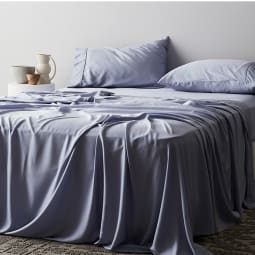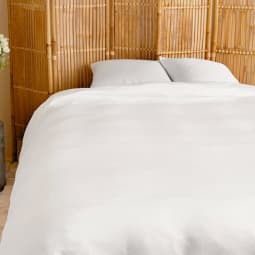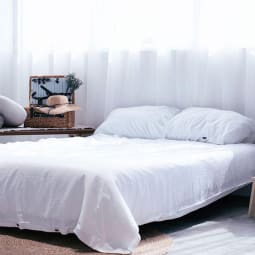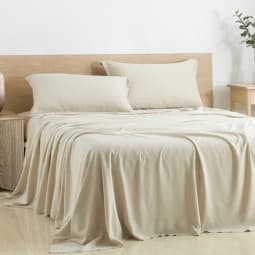By supporting companies doing it right, we can all use our dollars to vote for a more sustainable future for this fabric. But what about their sheets? Ettitude’s signature bamboo lyocell set is woven in a silky sateen weave. Customers note that their soft feel, temperature-regulating qualities, and rich colors make them a great option for all kinds of sleepers—especially if you tend to run warm at night. Lyocell does tend to wrinkle over time, and some reviewers note that these can come out of the laundry looking worn. Note that since this is a European company, you’ll want to double-check on sheet size before ordering. Note that since this is a Singaporean company, you’ll want to double-check on sheet size before ordering. Reviewers note that the bamboo blend does tend to wrinkle but is incredibly soft and cooling for all kinds of sleepers. But obviously, the bamboo that’s harvested isn’t quite ready to drape your bed just yet. First, its pulp needs to be broken down and turned into a fiber that’s soft enough to sleep on. This requires the use of chemical solvents, so although bamboo on its own is a natural fiber, bamboo sheets are heavily processed. Most bamboo sheets are made using a viscose process: The bamboo is broken down, crushed, mixed in a bath of chemicals, and then spun into yarn. This method comes with a few environmental concerns, which you can read up on here. Sheets made using a viscose process will typically be labeled “viscose made from bamboo” or “rayon made from bamboo.” (In the U.S., they legally can’t1 just be called “bamboo” because of all this processing.) Bamboo sheets can also be made using a lyocell production method. This method uses slightly gentler solvents, repurposes them in a closed-loop system, and tends to be more eco-friendly. After pulling back the covers on the bamboo sheet industry and analyzing the options currently available, researchers concluded that lyocell is “considered to be one of the leading methods of producing environmentally friendly regenerated fibers for textiles” in a 2016 paper in the journal Fashion and Textiles2. Sheets made this way will be labeled “bamboo lyocell” and they’ll probably be more expensive than viscose options. The most common types of weaves for bamboo sheets are percale and sateen. Percale is made by weaving a one-yarn-under, one-yard-over grid, which makes them crisp and lightweight. They tend to be a good option for the summertime. Sateen is made by weaving one yarn under and three to four yarns over, so it’s thicker but still cooling.









